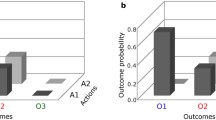Abstract
This research examines the roles of both approach–avoidance and approach–approach conflicts in the relationship between the degree of deliberation and persistence of preference for the chosen option. In three experiments, we reverse the negative effect of deliberation on persistence reported by Nordgren and Dijksterhuis (2009). In study 1A, we conceptually replicate Nordgren and Dijksterhuis’s results in a choice context with simultaneous presentation of options. In study 1B, we reversed this effect by making minor alterations to the choice set. When the choice set contains a brand with advantage on an irrelevant attribute with conflict caused by the more important attributes remains unchanged, deliberation leads to greater preference stability. In study 2, we obtain process evidence for a reduction in conflict and dominance structuring caused by discrimination in terms of an irrelevant attribute. In study 3, we found that when choice set induces conflict between two attractive options, deliberation causes persistent preference. In study 4, we vary perceived conflict without varying the choice set and replicate the effects obtained in experiments 1A and 1B. Thus, our studies provide evidence for the roles of approach–avoidance and approach–approach conflicts (Coombs and Avrunin 1988) in the deliberation–persistence relationship.
Similar content being viewed by others
References
Bettman, J. R., Luce, M. F., & Payne, J. W. (2008). Consumer decision making: A choice goals approach. In P. Haugtvedt, P. M. Herr, & F. Kardes (Eds.), Handbook of consumer psychology (pp. 589–610). New York: Lawrence Erlbaum Associates.
Carpenter, G. S., Glazer, R., & Nakamoto, K. (1994). Meaningful brands from meaningless differentiation: The dependence on irrelevant attributes. Journal of Marketing Research, 31(1), 339–350.
Coombs, C. H., & Avrunin, G. S. (1988). The structure of conflict. Hillsdale, NJ: Erlbaum.
Coombs, C. H., Avrunin, G. S. (1977). Single-peaked functions and the theory of preference. Psychological Review, 84(2), 216–230.
Dijksterhuis, A., & Nordgren, L. F. (2006). A theory of unconscious thought. Perspectives on Psychological Science, 1, 95–109.
Feldman, J. M., & Lynch, J. G. (1988). Self-generated validity and other effects of measurement on belief, attitude, intention, and behavior. Journal of Applied Psychology, 73(3), 421–435.
Houston, D. A., Sherman, S. J., & Baker, S. M. (1991). Feature matching, unique features, and the dynamics of the choice process: Pre-decision conflict and post-decision satisfaction. Journal of Experimental Social Psychology, 27(5), 411–430.
Liberman, N., & Forster, J. (2006). Inferences from decision difficulty. Journal of Experimental Social Psychology, 42, 290–301.
Montgomery, H. (1983). Decision rules and the search for a dominance structure: Towards a process model of decision making. In P. Humphreys, O. Svenson, & A. Vari (Eds.), Analysis and aiding decision processes (pp. 343–369). Amsterdam: North-Holland.
Montgomery, H., & Willen, H. (1999). Decision making and action: The search for a good structure. In P. Jusslin & H. Montgomery (Eds.), Judgment and decision making: Neo-Brunswikian and process-tracing approaches (pp. 147–173). Mahwah, NJ: Erlbaum.
Muthukrishnan, A. V., & Wathieu, L. (2007). Superfluous choices and persistence of preferences. Journal of Consumer Research, 33(4), 454–460.
Nagpal, A., Khare, A., Chowdhury, T., Labrecque, L. I., & Pandit, A. (2011). The impact of the amount of available information on decision delay: The role of common features. Marketing Letters, 22(4), 405–421.
Nordgren, L. F., & Dijksterhuis, A. P. (2009). The devil is in the deliberation: Thinking Too much reduces preference consistency. Journal of Consumer Research, 36(1), 39–46.
Payne, J. (1982). Contingent decision behavior. Psychological Bulletin, 92(September), 382–402.
Payne, J. W., Sampers, A., Bettman, J. R., & Luce, M. F. (2008). Boundary conditions on unconscious thought in complex decision making. Psychological Science, 19(11), 1118–1123.
Petty, R. E., Haugtvedt, C., & Smith, S. (1995). Elaboration as determinant of attitude strength. In R. E. Petty & J. A. Krosnick (Eds.), Attitude strength: Antecedents and consequences (pp. 93–130). Hillsdale, NJ, England: Lawrence Erlbaum.
Simonson, I. (2008). Regarding inherent preferences. Journal of Consumer Psychology, 18(3), 191–196.
Tesser, A., & Leone, C. (1977). Cognitive schemas and thought as determinant of attitude change. Journal of experimental Social Psychology, 13(July), 340–356.
Tormala, Z. L., & Petty, R. E. (2004). Resistance to persuasion and attitude certainty: The moderating role of elaboration. Personality and Social Psychology Bulletin, 30, 1446–1457.
Wilson, T. D., & Schooler, J. W. (1991). Thinking too much: Introspection can reduce the quality of preferences and decisions. Journal of Personality and Social Psychology, 60(2), 181–192.
Wilson, T. D., Dunn, D. S., Kraft, D., & Lisle, D. J. (1989). Introspection, attitude change, and attitude-behavior consistency: The disruptive effects of explaining why we feel the way we do. In L. Berkowitz (Ed.), Advances in experimental social psychology (Vol. 19, pp. 123–205). Orlando, FL: Academic Press.
Wood, W. (1982). The retrieval of attitude-relevant information from memory: Effects on susceptibility to persuasion and on intrinsic motivation. Journal of Personality and Social Psychology, 42(5), 798–810.
Yoon, S. O., & Simonson, I. (2008). Choice set configuration as a determinant of preference attribution and strength. Journal of Consumer Research, 35(2), 324–336.
Acknowledgments
We thank the Editor and a reviewer for their comments and suggestions. The research was supported by a grant from the Hong Kong Research Grant Council (HKUST-SBI13BM10). The first author acknowledges the support received from Indian School of Business during his term there as Visiting Scholar (2013–14).
Author information
Authors and Affiliations
Corresponding author
Appendix A
Appendix A
Choice set in Exp 1A (time 1 choice)
Rights and permissions
About this article
Cite this article
Muthukrishnan, A.V., Chark, R. Choice set induced conflict, deliberation, and persistent preference. Mark Lett 26, 437–448 (2015). https://doi.org/10.1007/s11002-013-9277-7
Published:
Issue Date:
DOI: https://doi.org/10.1007/s11002-013-9277-7




